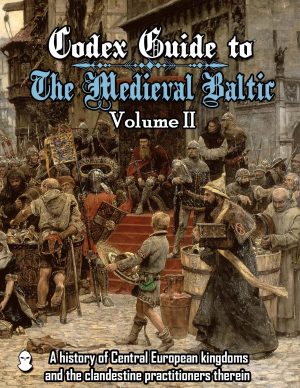The year is 1456. The place is the Southern Baltic. The Free City of Danzig is in rebellion against the Brother- Knights of the Teutonic Order. Privateers flying the Danzig colors patrol the waters of the Baltic all the way from Reval to Denmark. Bearing letters of marque they will intercept any vessels attempting to reach the Ordernstadt: the Monastic State of the Teutonic Order. Their crews are armed with crossbows, firearms, and cannon, and wear the armor of Medieval Knights. Gunboats, similarly armed with swivel guns, crossbows and breach loading cannon, patrol the Vistula river, engaging any enemy forces they encounter.
Professional contractors do most of the fighting in this war… Bohemian heretics fight as mercenaries on both sides, and today they are preparing to sell three captured towns to the highest bidder. They are joined by Austrian, Scottish, Dutch, Swedish, and Italian mercenaries, each with their own small private armies.
The burghers of Danzig plot their strategy over chess games they play this evening in their merchants Guild hall named for King Arthur. Safe behind the mighty walls of their city, the city council composes a letter to their ally King Casimir IV Poland, seeking to coordinate a new offensive. Nearby, burghers drink beer with their wives in the public baths, taking a break from their long day of guard duty on the city walls, or working the foundry in one of the cities water powered mills. At the river front, the seven story high automated crane unloads gunpowder, salt, pickles, and two hundred kegs of beer from an ocean going carrack just arrived from Bruges in Belgium, having crossed the multiple blockades under the safe passage of the Prussian Confederation and the Hanseatic League. The citizens will celebrate tonight, for tomorrow is the feast of St. Vitus.
A few hundred miles to the east in nearby Lithuania, the eerie primordial groves of a vast forest called the Grauden echo with the chants of pagan priests of the wild Samogitians, who still practice their ancient pre-Christian faith. This night they will give sacrifice to their heathen god Kupolė by bathing naked in the river in the moonlight. They will dance the wild primal dance around the fire without fear of interference. The Teutonic Knights invaded this land annually for two hundred years in a vain attempt to convert the population to the rule of Christ. Eventually they gave up, and the Samogitians are their own masters this day.
Meanwhile in his impregnable three level castle of Malbork, the Grand Master of the Teutonic Order, Ludwig von Erlichshausen consults with his mercenary captains and brother-knights. His castle is surrounded by enemy forces who occupy the town of Marienburg, but he has plenty of cannon and sufficient supplies to hold out for years, and 100 iron-hard Brother Knights of the Teutonic Order beside him. The rebels dare not try to storm the walls, nor to even confront the armed river boats he is preparing to carry his orders to the other great fortress of the Order at Konigsberg. They are gathering their forces, raising money, and preparing a mighty counterstroke against the enemies of St. Mary and the righteous Teutonic Knights.
Further to the East, Mongol horse-archers of the Golden Horde check their saddles and water their horses as they prepare to make a slave raid deep into Poland. This is what they call ‘harvesting the steppe’. Their vassals in Muscovy not far away, give prayers to St. Vitus as they forge new gun barrels and build up their city walls for the inevitable next violent encounter with their overlords. Further to the south, escaped Ukranian slaves in an outlaw Cossack band are making preparations of their own, planning their own violent night time raid into the land of the Mongols, to steal horses, women, and gold.
In the north, Swedish and Finnish fur trappers hunt a wounded wild boar on skis, eager to bring food back to their trapping camp where they have been collecting beaver pelts. Little do they know, a pack of wolves is stalking them, and the alpha male waits patiently for the men to become separated. Not far away on a hilltop, armed Druzhina from Novgorod watch the drama unfold, not sure yet if they will rob the Swedes, or save them from the wolf attack.
This is not the familiar fantasy world of orcs and elves, it is a place you have never been before. This is the historical reality of life in the 15th Century Baltic. It’s a tough place, a place where high technology and sophisticated urban life exist only a few miles away from primitive tribesmen, struggling for survival. It is a land of many ethnicities and language groups, religions and social classes, where adventure, honor, and wealth beyond the wildest dreams of fantasy can be won by the daring, but swift death awaits both the foolish and the unlucky.
You have been to Narnia and Middle Earth, to Cimmmeria and even the hideous plateau of Leng. But you have never been to this place. Are you ready to take a giant leap to 500 years in the past?
The Codex Guide to the Medieval Baltic, now available for purchase, is a general historical overview of the Baltic region in 1456 AD suitible for use by gamers, historical fencers, re-enactors, military historians, and anyone curious about life in Northeastern Europe 500 years in the past.



Reviews
There are no reviews yet.